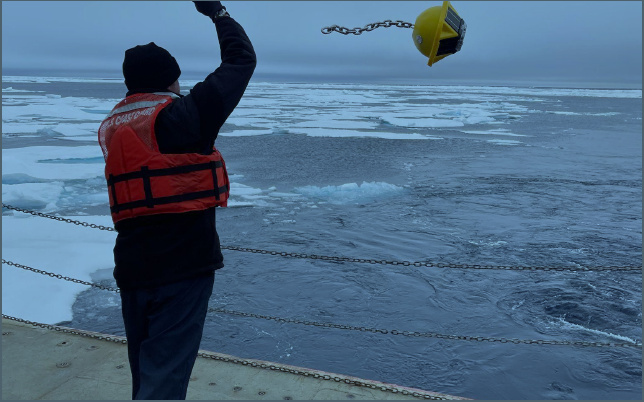U.S. National Ice Center Deploys Buoy in Data-Sparse’d Arctic
By LT Jacquelyn Putnam, NOAA
NIC.PAO@noaa.gov
U.S. National Ice Center
August 15, 2022
The U.S. Naval Meteorology and Oceanography (Naval Oceanography) representation from U.S. National Ice Center (USNIC) were part of personnel aboard the USCGC Healy (WAGB-20) to successfully deploy Sofar Ocean spotter-buoys during its patrol to the North Pole, this Summer.
Currently, Chief Warrant Officer (CWO2) Mike Latin, Operations Officer at USNIC is deployed onboard the Healy—and will oversee execution of the buoys’ deployment.
The first buoy was successfully deployed in early August, and the final buoy will deploy later in the month.
"USNIC's role in the Healy's Arctic Patrol is an example of the 'Advantage at Sea' maritime strategy the U.S. Navy, U.S. Coast Guard, and U.S. Marine Corps are working to achieve,” said Latin. “We leverage capabilities of one another to accomplish goals like weather and oceanographic sensing in a remote area like the Arctic….[t]his would be a much more difficult without the Healy’s icebreaking capability and professionalism of its crew.”
A Cooperative Research and Development Agreement (CRADA) between Naval Oceanography and Sofar Ocean was developed for the deployment of these five spotter-buoys in the Arctic during the Healy’s deployment.
This particular CRADA allows the U.S. Navy and private stakeholders to collaborate and develop capabilities that support the Fleet’s mission.
“I am incredibly proud of this team and the work they are doing,” said USNIC Director, U.S. Navy Commander Casey Gon. “Teaming with industry (Sofar Ocean), allows the collective to attack complex issues of sensing and observing the harshest environment in the world [Arctic]…[t]hese observations will help inform analysts, mariners, scientists and models on the actual environmental conditions… partnerships are critical to our mission success and execution.”
Sofar Ocean spotter-buoys represent an opportunity for USNIC, and subsequently Naval Oceanography’s enterprise, to fill capability gaps in observation data; the buoys are compact, deployable from surface vessels—and designed to withstand harsh conditions in high latitudes.
The buoys will collect essential oceanographic data in data sparse environments that will record and report: waves, wind, sea surface temperature, and barometric pressure—in real-time through iridium communications—once activated.
Sofar Ocean is capable of large-scale ocean data solutions, with over 1k spotter buoys currently in its global network.

USNIC is a multi-agency center—subordinate to Naval Oceanography—operated by the Navy, NOAA, and Coast Guard and provides global to tactical scale snow and ice products, ice forecasting, and related environmental intelligence services for the United States government.
Naval Oceanography directs and oversees more than 2,500 globally-distributed military and civilian personnel who collect, process, and exploit environmental information to assist Fleet and Joint Commanders in all warfare areas to make better decisions faster than the adversary.
For more information, please contact:
National Ice Center
Command Duty Officer
Voice: (301) 943-6977
E-mail: nic.cdo@noaa.gov
Twitter: @usnatice
Facebook: @usnatice